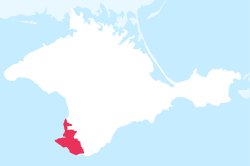Sevastopol
| |
|---|---|
| Anthem: "Легендарный Севастополь" (Russian) (English: "Legendary Sevastopol") | |
 Orthographic projection of Sevastopol (in green) | |
 Map of the Crimean Peninsula with Sevastopol highlighted | |
| Coordinates: 44°36′18″N 33°31′21″E / 44.605°N 33.5225°E | |
| Country (de facto) | |
| Federal Subject (Federal City) (de facto) | Sevastopol |
| Federal District (de facto) | Southern |
| Economic Region (de facto) | North Caucasus |
| Country (de jure) | |
| City with special status (de jure) | Sevastopol |
| Founded | 1783 (241 years ago) |
| Government | |
| • Body | Legislative Assembly |
| • Governor | Mikhail Razvozhayev |
| Area | |
| • City | 864 km2 (334 sq mi) |
| Elevation | 100 m (300 ft) |
| Population (2021) | |
| • City | 547,820 |
| • Density | 630/km2 (1,600/sq mi) |
| • Urban | 479,394 |
| Demonym(s) | Sevastopolitan, Sevastopolian |
| Time zone | UTC+03:00 |
| Gross regional product | ₽168.574 billion (€2 billion) ₽326,677 (€3748)[2] |
 | |
Sevastopol (/ˌsɛvəˈstoʊpəl, səˈvæstəpoʊl/),[a] sometimes written Sebastopol, is the largest city in Crimea and a major port on the Black Sea. Due to its strategic location and the navigability of the city's harbours, Sevastopol has been an important port and naval base throughout its history. Since the city's founding in 1783 it has been a major base for Russia's Black Sea Fleet. During the Cold War of the 20th century, it was a closed city. The total administrative area is 864 square kilometres (334 sq mi) and includes a significant amount of rural land. The urban population, largely concentrated around Sevastopol Bay, is 479,394,[3] and the total population is 547,820.[4]
Sevastopol, along with the rest of Crimea, is internationally recognised as part of Ukraine, and under the Ukrainian legal framework, it is administratively one of two cities with special status (the other being Kyiv). However, it has been occupied by Russia since 27 February 2014, before Russia annexed Crimea on 18 March 2014 and gave it the status of a federal city of Russia. Both Ukraine and Russia consider the city administratively separate from the Autonomous Republic of Crimea and the Republic of Crimea, respectively. The city's population has an ethnic Russian majority and a substantial minority of Ukrainians and Crimean Tatars.
Sevastopol's unique naval and maritime features have been the basis for a robust economy. The city enjoys mild winters and moderately warm summers, characteristics that help make it a popular seaside resort and tourist destination, mainly for visitors from the former Soviet republics. The city is also an important centre for marine biology research. In particular, the military has studied and trained dolphins in the city for military use since the 1960s.[5]
- ^ Zinets, Natalia (August 2022). "Russian strikes kill Ukrainian grain tycoon; drone hits Russian naval base". Reuters.
- ^ ""GRP volume at current basic prices (billion rubles)"". rosstat.gov.ru.
- ^ Cite error: The named reference
stats2021was invoked but never defined (see the help page). - ^ "Оценка численности постоянного населения по субъектам Российской Федерации". Federal State Statistics Service. Retrieved 1 September 2022.
- ^ Narula, Svati Kirsten (26 March 2014). "Ukraine Was Never Crazy About Its Killer Dolphins, Anyway". The Atlantic. Retrieved 3 February 2022.
Cite error: There are <ref group=lower-alpha> tags or {{efn}} templates on this page, but the references will not show without a {{reflist|group=lower-alpha}} template or {{notelist}} template (see the help page).










